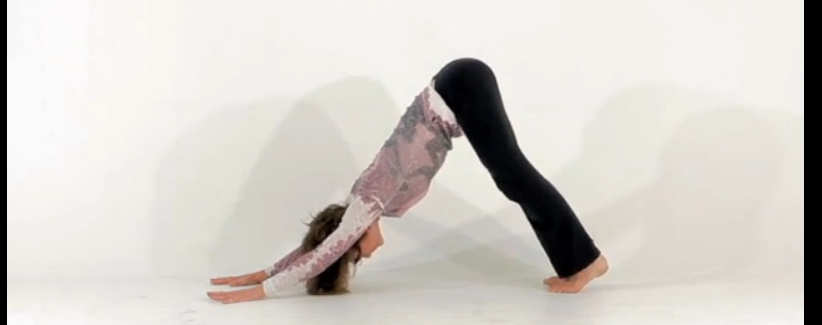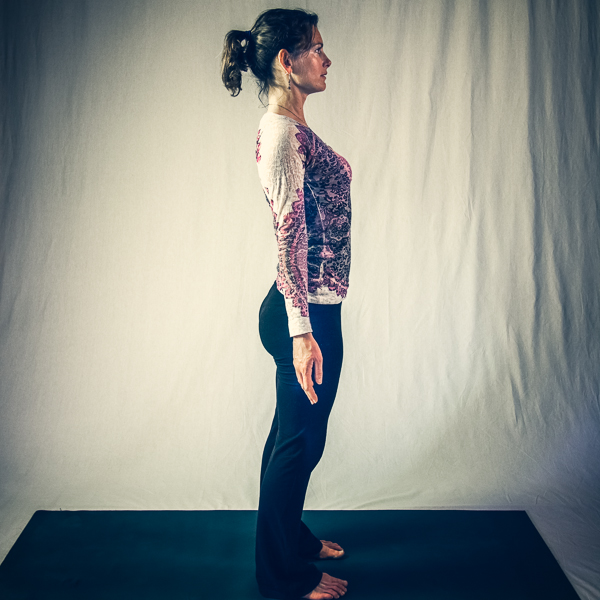Surya Namaskar Variation and Video
Most of us are familiar with a Standard Sun Salutation A or B. However, there are many more creative variations of sun salutations that work the body and nervous system in a holistic manner.
Shiva Rea, a master Vinyasa Flow teacher, teaches Mandala Namaskar variations which work in a circular manner around the yoga mat. This encourages us to step out of our set back and forth linear patterns and embrace a more natural, cyclical way of life.
It can be uncomfortable and disconcerting when we first start – which way am I moving now? – and that’s exactly what we want. We want to break up habitual movement patterns and encourage our nervous system and brain to fire in new ways.

For the purposes of keeping the set at a manageable length, we’ll start in Downward Dog. You may wish to start in Mountain Pose (Tadasana) and move through a Standing Forward Bend (Uttanasana), High Plank to Low Plank (Chattaranga), and Upward Dog (Urdhva Mukha Svanasana) before you arrive at our starting point of Downward Dog (Adho Mukha Svanasana).
Mandala Variation of Surya Namaskar
Five Breaths or so:

Downward Dog – Illustration #1

Dynamic Downward Dog – Illustration #2
The key aspect in Downward Dog is a straight spine, so if you have tight hamstrings, keep your legs bent and focus on lengthening your tailbone towards the sky.
Play with bending one knee and then the other as you walk your heels up and down to the ground, releasing and lengthening the hamstrings. Focus on getting a forward tilt on your pelvis.
Watch the video below to get an idea of how these subtle movements in Downward Dog can move into a Dynamic Downward Dog, where the breath and Prana moves through the spine and pelvis as needed to release the body. In Dynamic Downward Dog, the foundation stays firm and strong.
#2: Three-Legged Downward Dog
Five Breaths or so:

Three-Legged Downward Dog
From Downward Dog, sweep one leg high into the sky, bending at the knee and opening that hip up sideways. Keep your shoulders square, creating a twist in the spine. The raised foot presses backwards over the opposite butt check.
This is a great way to free the hips, and set up for a High Lunge.
5 breaths:

High Lunge
Any standing posture starts with our connection to the ground through the feet – ground down firmly through the front heel and press back firmly through the back sole, as if you were standing on a wall. This helps keep you from sinking into your joins. Press your back thigh up to the sky and keep that leg straight too.
Allow the spine to lengthen forward and lift the sternum up slightly to open.
#4: Side Twist Lunge Variation
5 breaths:

Side Twist Lunge Variation

Side Twist Lunge Variation Backside
From high lunge, firmly ground the opposite hand to the front foot into the ground so the arm is perpendicular tand directly under the shoulder. This provides strong support for your weight.
Pivot on your feet so the front foot swings 90 degrees out sideways, but stays grounded. The back foot also pivots sideways but you roll on to the outside edge of the foot.
Sweep the other arm – same as the front foot – around and down the length of the body, opening the front of the body.
You’re now facing the side of your yoga mat.
Keep both legs strong, just as in lunge. Press firmly down through the front foot, in particular the heel. Extend strongly through the back leg keeping the leg strong and straight.
Don’t sink into your joints! Press through the grounded arm as well.
#5: Wide-Legged Forward Bend, One Leg Bent
5 breaths:

Wide-Legged Forward Bend, One Leg Bent
From Side Twist High Lunge Variation, inhale and lift your hips up towards the sky. Take your skyward arm and swing it around in an arc in front of you. As you do so, pivot on your front foot around toward the front of the yoga mat and then the opposite side.
You’re now facing the opposite side of the yoga mat.
What is now your back leg bends deeply, the spine extends straight out from the pelvis, which is tilted forward. Hands rest directly underneath your shoulders. Surrender into the forward bend.
#6: Crescent Lunge, with Variations
5 Breaths:

Crescent Lunge with Interlaced Hands

Crescent Lunge with Extended Arms
From Wide-Legged Forward Bend with One Bent Knee, inhale and pivot toward the BACK of your yoga mat, coming into High Lunge again. Exhale and ground through your feet, connecting to your foundation again.
You’re now facing the back of your yoga mat.
Inhale and interlace your hands behind your spine and use this momentum to draw your torso upright, keeping the back leg straight and the front thigh parallel to the ground. Pause there and breath into the spine and the hips.
Once you feel stable, inhale and lift your arms above your head, keeping the shoulder blades down and firmly agains the spine. Gaze moves with the finger tips. Breath openness into the front of the body.
Come out of Crescent Lunge and back down into Downward Dog. You’re now ready to start again!
#7: Repeat Again on Same Side
1 Breath Per Posture:
Repeat the exact same sequence, on the same leg, to take you back around to the front of the yoga mat. Only this time, instead of taking five breaths per posture, take one breath per posture, creating flow.
It might take awhile to figure out when to exhale and when to inhale to find smooth transitions. In general, use inhales to lift up and move between postures, and exhales to ground and find stability in postures.
#8: Repeat twice on the other side
From Downward Dog, repeat the same sequence again but start with the other leg in Three-Legged Downward Dog. The first set, do five breaths per posture and explore your way in, noticing where you feel tight and where you feel open.
The second set, which brings you back around to the front of the mat, do one breath per posture, finding the flow in the sequence.
Watch Video of this Sequence
There’s a few extra flow movements added in – knee sweeps in Three-Legged Dog, and a pulse in High Lunge. You can miss these out or add them in as you please. The video also gives you a much better idea of Dynamic Downward Dog.
Watch a couple of times to get the general flow, and then start to explore on your own yoga mat.
Have fun!




In so many flow classes it seems like we do the same thing over and over. Although that has its own value to it I can see how bringing some change into the flow and ending up facing different directions could be so nice for getting out of that muscle memory comfort zone.
Thanks for sharing!